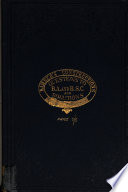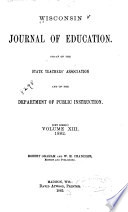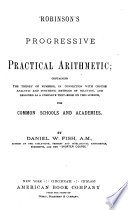 | John William Marshall - Arithmetic - 1879 - 306 pages
...2 dwts. x 10 To find the value of a fraction of a fraction, or to multiply one fraction by another, multiply the numerators for a new numerator, and the denominators for a new denominator. 237. £ of £5 14s. 4d. 6. f of £17 15s. 5d. 7. T\ of £12 14s. lOd. 8. f of £24 10s. 8fd. 9. | of... | |
 | Bible - 1879 - 820 pages
...others, three eighths ; and the series of fractions may be continued indefinitely by adding the last two numerators for a new numerator, and the denominators for a new denominator. In 1849 Professor Peirce showed that these numbers are the successive approximations to .88197 ; in... | |
 | Thomas Kimber - 1880 - 176 pages
...+ (ii)+ (in) + (iv) = 3-1-1-1 = o. 4. •.' the fractions are equal, the fraction formed by adding the numerators for a new numerator and the denominators for a new denominator is equal to each. The new fraction is which = — -н!М— i whether a + b + c+d vanishes or not.... | |
 | Simon Newcomb - Algebra - 1882 - 302 pages
...suppose •=-, and is to be multiplied by —, am am Hence r- X — = -7 — • on bu That is, me multiply the numerators for a new numerator, and the denominators for a new denominator. The result should then be reduced to lowest terms. EXERCISES. Execute the following multiplications:... | |
 | Education - 1882 - 598 pages
..."200,000;" never for an instant considering the population of Ohio's largest city. "To add fractions, add the numerators for a new numerator, and the denominators for a new denominator." "Shall we continue in sin that grace may abound?" "7/4a/ is an adjective and limits grace." "That is... | |
 | Education - 1883 - 654 pages
..."200.000;" never for an instant considering the population of Ohio's largest city. " To add fractions, add the numerators for a new numerator, and the denominators for a new denominator." " Shall we continue in sin that grace may abound? " " That is an adjective and limits grace." " That... | |
 | Edson Sewell Bastin - Botany - 1887 - 312 pages
...observed also that the third fraction of the series is derivable from the first two by adding together the numerators for a new numerator and the denominators for a new denominator ; that the fourth is derived from the second and third in the same way, and so on. Examples of the... | |
 | Warren H. Sadler - 1888 - 426 pages
...terms, obtaining the result in lowest terms ^i, 5 x ^s = 6 without further reduction. zs Rule. — Multiply the numerators for a new numerator and the denominators for a new denominator, first canceling all factors which are common to opposite terms. NOTE 1. — If one or both factors... | |
 | Horatio Nelson Robinson - 1888 - 372 pages
...general RULE. I. Reduce all integers and mixed numbers to im^ proper fractions. II. Multiply together the numerators for a new numerator, and the denominators for a new denominator. Cancel all factors common to numerators and denominators. 2. Multiply I by $. Ans. $. 3. Multiply J... | |
 | Caton's national business college, Buffalo, N.Y. - 1889 - 330 pages
...with 1 as their denominators. Thus, (1) $T\ x \ — ? ; (2) $J x *£ = ? ; (8) ffxf = ? / RULE. — Multiply the numerators for a new numerator and the denominators for a new denominator, first canceling all factors which are common to opposite terms. NOTE 1. — If one of the factors is... | |
| |